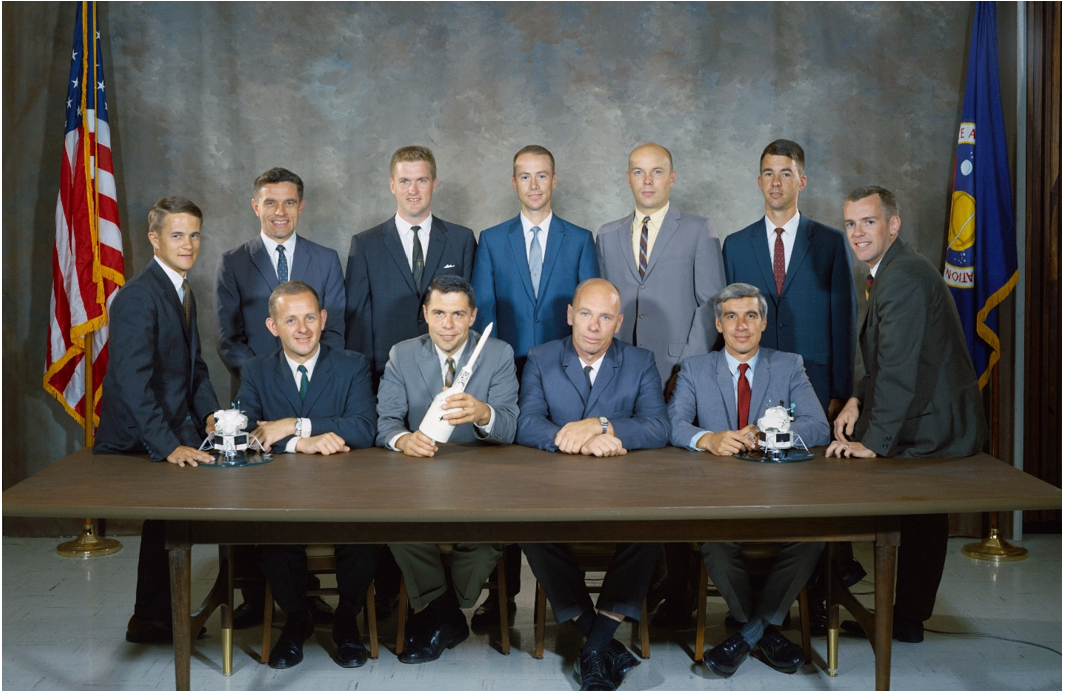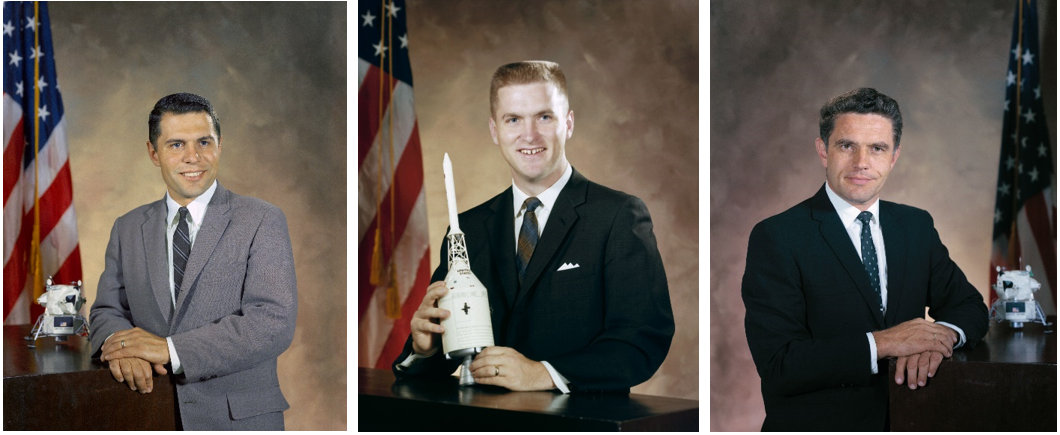55 Years Ago: NASA Selects 11 Scientist-Astronauts
On Aug. 4, 1967, NASA and the National Academy of Sciences announced the selection of 11 new scientist-astronauts. Chosen from 923 applicants, the Group 6 astronauts included three medical doctors, three astronomers, two physicists, one geophysicist, one electrical engineer, and one chemist. After initial orientation and academic instruction, in March 1968 the group began 13 months of jet-pilot training — during which two elected to resign. The rest returned to NASA in April 1969 and received technical assignments in the Astronaut Office, supporting either the Apollo Program or the Apollo Applications Program, later renamed Skylab. Two more resigned in the early 1970s before making a spaceflight. While waiting 15 to 18 years for their first space mission, the remaining seven Group 6 astronauts distinguished themselves supporting the Apollo, Skylab, and Space Shuttle Programs. In total, they completed 15 flights aboard the space shuttle.

The Group 6 scientist-astronauts: front row, Philip K. Chapman, left, Robert A.R. Parker, William E. Thornton, John A. Llewellyn; back row, Joseph P. Allen, left, Karl G. Henize, Anthony W. England, Donald L. Holmquest, F. Story Musgrave, William B. Lenoir, and Brian T. O’Leary. Credits: NASA
On Sept. 26, 1966, NASA and the National Academy of Sciences released a joint announcement seeking qualified scientists to apply for NASA’s astronaut corps. The announcement came a little more than one year after NASA selected its first group of six scientist-astronauts and six months after selection of 19 new pilot-astronauts. At this time, NASA believed it needed the additional astronauts to support upcoming Apollo and Apollo Applications Program (AAP, and later renamed Skylab) missions. From the 923 applications received by the deadline of Jan. 8, 1967, the academy narrowed the field down to 69 candidates based on their academic credentials. This group underwent medical examinations at the School of Aerospace Medicine at Brooks Air Force Base in San Antonio in the spring of 1967, further narrowing the number of candidates to 21. That group came to the Manned Spacecraft Center (MSC) in Houston, now NASA’s Johnson Space Center, for interviews with the selection committee. They also received a demonstration flight in the back seat of a T-38 jet aircraft so doctors could assess their reaction. From this group, NASA selected the 11 new scientist-astronauts, formally announcing their names on Aug. 4, 1967:
- Joseph P. Allen, Ph.D. in physics from Yale University
- Phillip K. Chapman, Sc.D. in instrumentation from the Massachusetts Institute of Technology (MIT)
- Anthony W. England, Ph.D. in geophysics from MIT
- Karl G. Henize, Ph.D. in astronomy from the University of Michigan
- Donald L. Holmquest, M.D. and Ph.D. in physiology from Baylor College of Medicine
- William B. Lenoir, Ph.D. in electrical engineering from MIT
- John A. Llewellyn, Ph.D. in chemistry from University College, Cardiff, Wales
- F. Story Musgrave, M.D. from Columbia University
- Brian T. O’Leary, Ph.D. in astronomy from the University of California, Berkeley
- Donald A.R. Parker, Ph.D. in astronomy from the California Institute of Technology
- William E. Thornton, M.D. from the University of North Carolina
The group included the first two naturalized U.S. citizens selected as astronauts, with Chapman from Australia and Llewellyn from Wales. Holmquest deferred his astronaut duties for nearly a year while he finished his medical internship at The Methodist Hospital in Houston.
The group reported for duty at MSC on Sept. 18, 1967, increasing the number of active astronauts to 56. During their first meeting with Director of Flight Operations Donald K. Slayton, he frankly informed them that it may be some time before they could expect a flight assignment. The many pilot-astronauts and the scientist-astronauts from the 1965 selection already in the program had priority for assignments to a diminishing number of flight opportunities. In the year since NASA released the announcement, the agency’s budget cuts had reduced the number of flights, especially AAP opportunities. Feeling a bit like extras in the Astronaut Office, the Group 6 scientist-astronauts gave themselves the nickname “XS-11,” or “Excess 11.”

Left: The Group 6 scientist-astronauts meet the press — William E. Thornton, left, Joseph P. Allen, Karl G. Henize, Donald L. Holmquest, Brian T. O’Leary, F. Story Musgrave, Phillip K. Chapman, John A. Llewellyn, William B. Lenoir, Anthony W. England, and Robert A.R. Parker. Right: Nine of the 11 scientist-astronauts pose for a photograph in February 1968 outside the auditorium at the Manned Spacecraft Center shortly before their departure for jet-pilot training. Credits: NASA
As one of their first tasks, they held a press conference in MSC’s Building 6 off-site press center on Sept. 19. Their first two weeks consisted of orientation to the center and its facilities, followed by several months of extensive classroom instruction on a broad range of subjects. They also visited other NASA facilities, including the observation of Apollo 5’s launch in January 1968, the uncrewed test flight of the Lunar Module. In late March and early April, the 10 astronauts paired up and left for five different Air Force bases for 13 months of jet-pilot training.

Group 6 astronauts Brian T. O’Leary, left, John A. Llewellyn, Phillip K. Chapman, and Donald L. Holmquest. Credits: NASA
Four of the Group 6 scientist-astronauts resigned from the program before making a spaceflight. O’Leary and Llewellyn resigned in April and August 1968, respectively, during the jet-pilot training phase. The remaining eight returned to MSC in April 1969 and received technical assignments supporting Apollo and AAP. Chapman made significant contributions to the program as the mission scientist and capsule communicator, or capcom, on Apollo 14 before retiring in 1972. Holmquest delayed his astronaut training a year to finish his medical internship. About a year after completing jet-pilot training, he began a one-year leave in June 1971 to pursue additional training in nuclear medicine at Baylor College of Medicine in Houston. He returned to MSC to continue work on Skylab before resigning from NASA in September 1973.

Group 6 astronauts Joseph P. Allen, left, William B. Lenoir, F. Story Musgrave, and William E. Thornton. Credits: NASA
Of the remaining seven astronauts, all made significant contributions to Apollo, Skylab, and the space shuttle before getting their chance to fly in space. Allen and Lenoir received the first flight assignments of the Group 6 astronauts as mission specialists on STS-5 in November 1982. Spacesuit problems on that flight thwarted their plans to conduct the first spacewalk of the Space Shuttle Program. Prior to that, Allen had served as mission scientist and capcom during the Apollo 15 moonwalks in July-August 1971 and as capcom on STS-1, the first space shuttle flight in April 1981. Lenoir had served as the backup science pilot for the second and third Skylab missions in 1973. Musgrave flew as a mission specialist on STS-6 in April 1983, participating in the Space Shuttle Program’s first spacewalk. Earlier in his career, he served as backup science pilot for the first Skylab mission in 1973 and later helped to develop spacesuits and spacewalk techniques for the space shuttle. He also participated as a crew member on the first and second ground-based Spacelab Mission Development (SMD) tests in October 1974 and January 1976. Prior to his first spaceflight to study space motion sickness on STS-8 in August 1983, Thornton served as the science pilot for the Skylab Medical Experiment Altitude Test, a 56-day ground-based simulation of a Skylab mission, from July to September 1972. He also participated as a mission specialist for the third SMD test in May 1977.

Group 6 astronauts Robert A.R. Parker, left, Anthony W. England, and Karl G. Henize. Credits: NASA
Prior to his assignment as a mission specialist on the first Spacelab mission during STS-9 in November 1983, Parker had served as the mission scientist for Apollo 17 and as the program scientist for Skylab. England and Henize waited the longest of the Group 6 astronauts to make their first flight, both as mission specialists on the STS-51F Spacelab-2 mission in 1985, flying 18 years after their selection. Prior to that, England had served as the mission scientist for Apollo 13 and 16, and then left NASA in 1972 to join the U.S. Geological Survey before returning to NASA in 1979 to resume astronaut training. Henize developed an ultraviolet spectrograph for Skylab and served as a capcom for Apollo and Skylab missions.

Summary of spaceflights by Group 6 astronauts.
In the final analysis, despite their initial nickname as the Excess 11, the Group 6 astronauts made significant contributions to the Apollo, Skylab, and Space Shuttle Programs. Among them, they completed 15 space shuttle missions, with Musgrave making six flights, flying on each of NASA’s five shuttle orbiters. He conducted four spacewalks, including the first of the program and three to service the Hubble Space Telescope. He completed the last flight from his group — STS-80 — in 1996, 29 years after his selection and 13 years after his first mission.
Musgrave was the last of the group to leave the agency when he retired on Sept. 2, 1997, closing out his 30-year stellar career and a storied chapter in NASA’s history.







